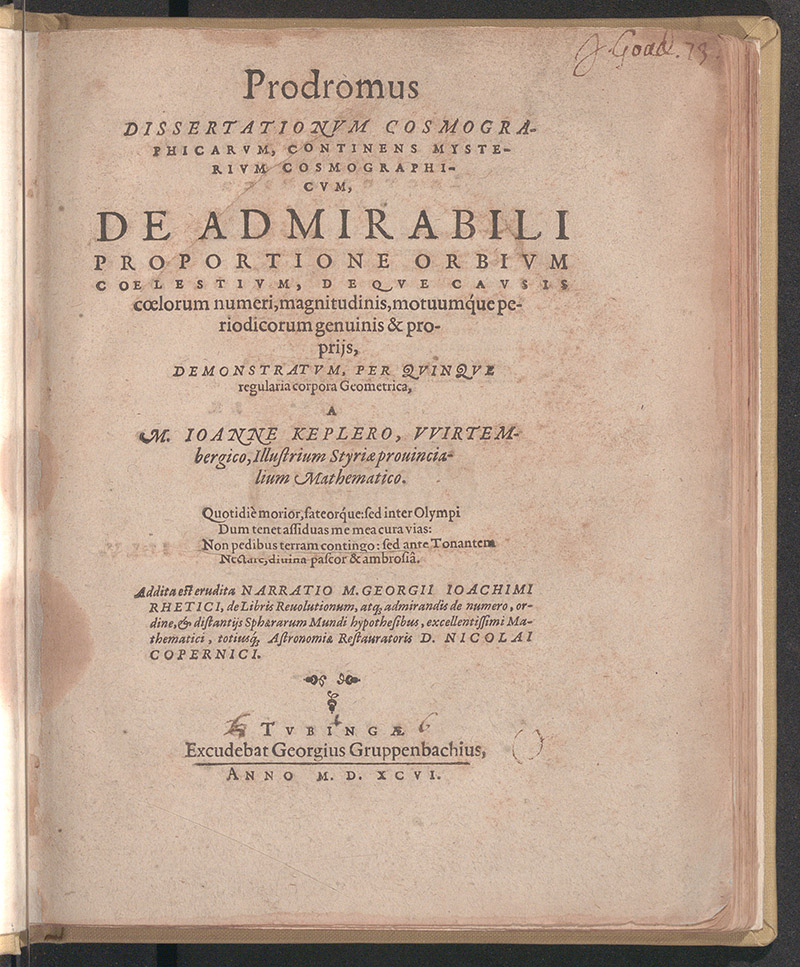Kepler’s Mysterium Cosmographicum

- Title page.
- Johannes Kepler (1571-1630).
- Prodromus dissertationum cosmographicarum, continens Mysterium Cosmographicum, de admirabili proportionem orbium coelestium, deque causis caelorum numeri, magnitudinis, motuumque periodicorum genuinis & propriis, demonstratum, per quinque regularia corpora geometrica.
- Tübingen: Georgius Gruppenbachius, 1596.
Born the son of a mercenary soldier in the German city of Weil der Stadt in 1571, Johannes Kepler received his education through a scholarship system designed to train teachers and Lutheran pastors in the Duchy of Württemberg. As a student of theology at the University of Tübingen, Kepler learnt about the Copernican system from the German mathematician and astronomer, Michael Maestlin. In 1591, he accepted an appointment as professor of mathematics at the Lutheran school in Graz, but he was removed from his post in 1600 when all Lutherans were expelled from the district. At the beginning of 1600 Kepler started collaborating with the famous Danish astronomer, Tycho Brahe and, having failed to obtain a teaching position at Tübingen, he resumed his work with Brahe by joining him at Prague. After Brahe’s death, Kepler succeeded him as royal mathematician to the Emperor Rudolph II, retaining this position under Emperor Matthias. Despite counting on the support of various patrons, Kepler’s last years were marked with financial and personal hardships, including his mother Katharina’s witchcraft trials.
The Mysterium Cosmographicum (The Cosmographical Secret) was a Prodromus (Preliminary Treatise) intended as the first of a series of books on cosmography which would endorse Copernicus’ heliocentrism through physical arguments instead of mathematical reasoning. Kepler’s intention in writing this work is clearly explained in its long title, which can be translated as follows:
A preliminary treatise consisting of cosmographical theses, containing the Cosmographical Secret on the marvelous proportion of the celestial spheres, and on the genuine and particular causes of the number, size, and periodic movements of the heavens, demonstrated by the means of five regular geometric bodies.
Based on the Copernican system, the Mysterium Cosmographicum proposes a cosmography theory in which the distances between the six known planets can be understood by the existence of a complex structure consisting of five regular polyhedrons, also known as the Platonic solids: their faces are identical in shape and size; all their angles and edges are congruent; and the same number of faces meet at each vertex. Broadly speaking, Kepler conceived the application of physics in his scientific project as a tool to reveal God’s intelligent design to the human mind.
Our copy includes an ownership inscription, followed by a number, on the top right corner: J. Goad. 75.
Select Bibliography
- Aiton, E. J. 1977. “Johannes Kepler and the ‘Mysterium Cosmographicum’.” Sudhoffs Archiv 61: 173-194.
- Holton, Gerald. 1956. “Johannes Kepler’s Universe: Its Physics and Metaphysics.” American Journal of Physics 24: 340-351.
- Kepler, Johannes. 1981. The Secret of the Universe: Mysterium Cosmographicum. Trans. A. M. Duncam. Intr. & Com. E. J. Aiton. New York: Abaris Books.